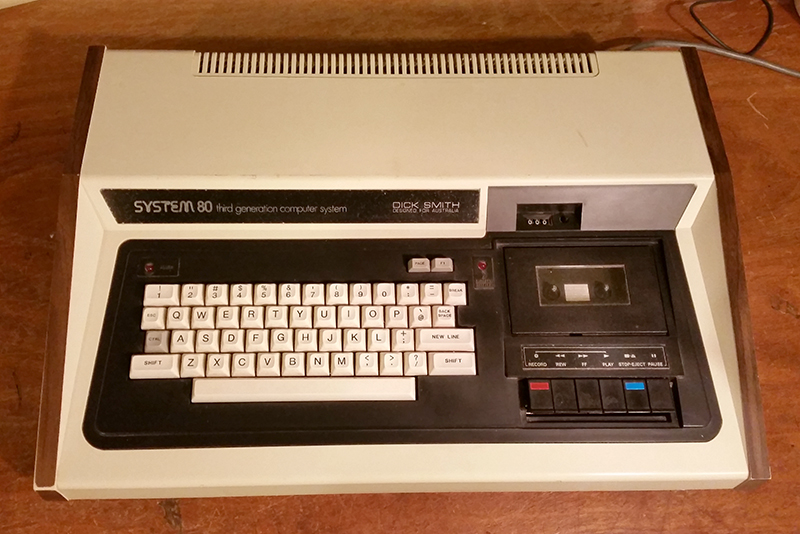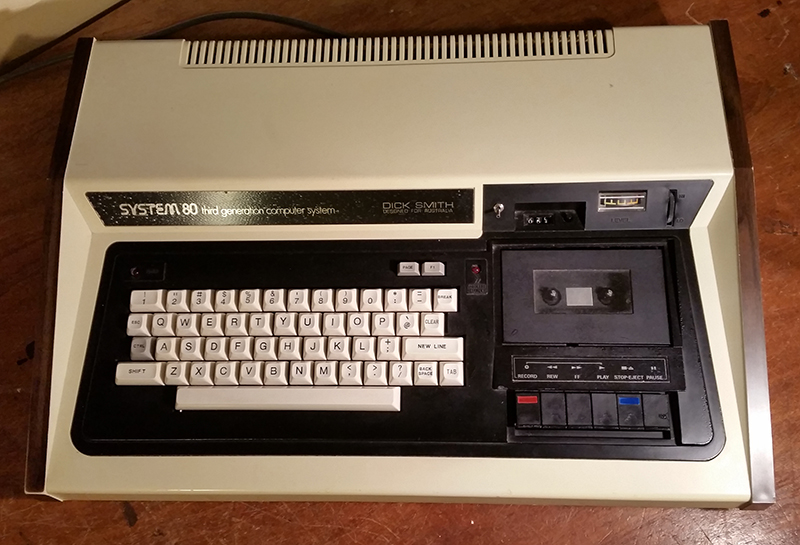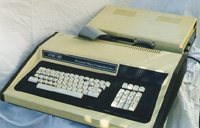System 80 Models and Variants
I.0 Introduction
2.0 System-80 Mark I (v.1)
2.1 Appearance
2.2 Specifications
2.3 Differences between the System-80 and the TRS-80 Model 1
3.0 System-80 Mark I (v.2a and v.2b)
4.0 System-80 Mark II (business model and "Educator")
5.0 System-80 (blue label)
1.0 Introduction
The following text details the form, function and various manifestations of the System 80. As the index above suggests, the machine went through several evolutionary variations. These were relatively minor, amounting mostly to incompatibility fixes and incorporating features which were available in earlier models as add-ons (such as lower case).
The interesting thing about these releases (apart from the Mark II) was that they were never publicised or heralded. The case still bore the simple name "System 80" with no version number to indicate the changes inside. The business model had the legend "Mark II" on the case but the names for the Mark I variants were ones that were given by users themselves. I've used the terms, version 1, version 2a and version 2b to distinguish between the different variants of the Mark I.
Those who want to take a closer look at the System 80 and what's inside can click here.
2.0 The System 80 Mark I (version 1)
Dick Smith Electronics Ltd (DSE) was the sole supplier of the System 80 to Australia and New Zealand, at least for 1980 and 1981. EACA also sold the machine to distributors in Western Europe as the Video Genie, and it appeared in the North American market as PMC-80.
A brand new System-80 retailed at about $NZ1200 or $A800 (about $US500). It came with 3 manuals.
Like the Model 1, the System-80 had a full-stroke keyboard but there the visual similarities ended. The latter was housed in an attractive sloping case, with tapering plastic wood-veneer sides. The keys were white, set in a black surround. The case itself was cream and black. Unlike the TRS-80 Model 1, the System 80 had the cassette recorder, RF modulator (so you could plug it straight into a TV) and power supply all built-in to the unit. With the early System 80s, if you looked closely you could see that two of the keys were missing, i.e. the CLEAR and Right Arrow key. The equivalent of the Up arrow in the Model I was called ESC, the down key (coloured grey) was CNTL and the Left Arrow key was called BACK SPACE. The ENTER Key was called NEW LINE.

Around the back of the unit was the on/off switch (on the right), the reset button (on the left) and a button called "Video cut" (about the middle).

The photo above shows what's on the back. The Video Cut button "cut" the video display in half, displaying the first 32 characters in a much larger font (handy for those less-than-ideal TV's).
The second, right-hand side of the output (also in the large font) could be viewed by pressing a grey button above the keyboard called PAGE. Just to the right of PAGE was a twin button labeled F1. Depressing it switched the cassette recorder on so that users could position the tape manually with the control buttons.
Under the hood, the System-80's specifications were very similar to the upgraded version of the TRS-80 Model 1. The unit was powered with a Zilog Z80 microprocessor running at 1.79Mhz. It ran an almost identical version of TRS-80 Level II BASIC. The first Dick Smith advertisments mention the basic model as having 4 kilobytes of RAM with an upgrade to 16k being an option. Some 4k RAM units may have been sold but it didn't take long for 16k RAM to be listed as the base memory. Characters were displayed on the screen 64 wide by 16 deep and graphics mode was 128 x 48 pixels on the same grid as the characters. Interfacing was done either through the second cassette port, or a 50-pin expansion bus unique to the System-80. This bus could interface with an optional System-80 expansion unit, offering 32K of extra memory, disk drives, a centronics-compatible parallel printer port and an RS-232.
Early System 80s had upper case only, but later models included lower case. Like the TRS-80 model 1, it suffered from keyboard bounce, which could be cured with either disk or cassette-based software routines.
For those of a more technical persuasion, I've included on this site scanned pages from the System 80 Technical Manual.
2.3 Differences between the original System 80 and the TRS-80 Model 1
- In the first release, two keys were absent, the CLEAR and the Right Arrow key (a serious deficiency for game players but rectified in the later System-80 release)
- The 32 character mode was achieved by way of the switch at the back of the unit called "Video Cut". A button on the top of the unit called "Page" showed the other 32 characters on the (now invisible) right-hand side of the screen. The normal way of achieving 32-character mode in the TRS-80 Model 1 was to use the BASIC command CHR$(23). In the System 80 all this did was to put a space after each character, effectively making the video display 32 characters wide, but with the same font as before.
- The unit had a built-in cassette deck and a second cassette port. The latter was only found on the expansion interface of the Model 1.
- An RF Modulator was built-in so you could plug the unit straight into a TV set.
- The "arrow keys" and ENTER had different labels (discussed above)
- The computer also showed different symbols corresponding to the arrow ASCII codes. The Up Arrow was "[", the Down Arrow was "\", the Left Arrow was "]" and the Right Arrow was "^". Similar to the TRS-80 Model 3.
- At non-disk boot-up "Memory size?" was "Ready?" and no copyright notices appeared when BASIC initialised.
- The printer port was addressed differently. The System-80 used the I/O address "FD" whereas that in the TRS-80 used memory address "37E8". This meant patching machine language programs like SCRIPSIT to get them to work.
- The serial interface was also addressed differently. In the System-80, I/O addresses "F8" and "F9" were used, whereas the TRS-80 used memory addresses "37DE" and "37DF".
- Switching between the two cassettes recorder ports differed in the use of addresses
Assembly-code aficionados wishing to explore the System-80 ROM calls can download and read Eddy Paay's (TRS-80 Model 1) Level II ROM Reference Manual or his Level 2 ROM Assembly Language Toolkit (kindly supplied by Alan Laughton, Aust.) from this site. Click here to see the exact ROM differences between the System-80 and the TRS-80 ROM that was available (i.e. Version 1.2) when the System 80 was developed.
A frank and detailed review of the original System-80 (from the pages of Micro-80) can be found here. Another review (this one from 80-Microcomputing) can be read on www.trs-80.com here.
3.0 System-80 Mark I (versions 2a and b)
Version 2a
The biggest headaches for users of TRS-80 software on the new System-80s was the absence of the two "missing" keys (used by most games) and the built-in cassette deck with no volume control, which often failed to load programs.
Realising the problems with their new microcomputer were not insignificant, Dick Smith Electronics Ltd took an active lead in trying to fix them. They produced Technical Bulletins on how to modify systems to overcome these difficulties, and many owners with soldering skills took up the challenge. DSE technical staff (notably Technical Service Manager Garry Cratt, Jim Rowe and Rex Callaghan) also spent a lot time visiting EACA, working on minor improvements to the basic model, disk expansion and improving EACA's quality control.
Jim Rowe pushed EACA to restore the two missing keys and also lead the charge for a gain meter and volume control to make tape loading more reliable. The latter was resisted by EACA who thought they could solve the tape loading problem by other means, but in the end they gave into DSE's insistence.

Thankfully then, the two (glaring!) deficiencies were addressed in late 1980 when System-80s (version 2a) started to ship with a TAB (i.e Right Arrow) and a CLEAR key. This had been achieved by substituting the large right hand shift key, with two buttons, a re-located BACKSPACE key, and a TAB key. CLEAR was placed where the BACKSPACE used to be, just above NEW LINE. Also included was the cassette volume control and gain meter discussed above, allowing users to monitor and adjust cassette output. Tape loading was still slow but much less frustrating.
You can see the added keys and the cassette deck additions in the photo above (NB. The switch by the counter is an after-market addition).
It was one of these machines that introduced me to the world of the System-80 (and TRS-80ism in general) in 1981. This improved version was a big hit and many units were sold throughout New Zealand and Australia that year.
Version 2b
After October, 1981 the units started to ship with a new video board which had lower case fitted. Like most of the System-80 improvements, this was completely unheralded and buyers were often unaware of the inclusion until they ran a lower-case driver! Another difference related to the keys. BACKSPACE, TAB, ESC and CNTL were replaced with arrow keys. This had a certain irony as (unlike the TRS-80 Model 1) there were no arrow characters in the System-80 character set! However, as software game instructions (written primarily for the TRS-80 Model 1 rather than the System 80 specifically) often referred to "the arrow keys", it was good sense to show users just which keys these were. Especially now they were all present!
4.0 System-80 Mark II (business model and "Educator")
 In
1981, the world of personal computing had not yet split into "home"
or "business" camps, but the seeds of this dichotomy were beginning
to germinate. At the same time the second version of the System-80 was
released, EACA also released a business model, subtitled the Mark II.
This model (which had also been instigated by DSE's Jim Rowe) replaced
the built-in cassette deck with a numeric keypad. It also included lower
case, which the standard System-80 units did not have (although lower-case
kits were available and, invariably, added to older units). Other extras
included an expanded ROM containing the lower-case driver, auto repeat,
flashing cursor and a screen print function. It also provided terminal
features and function keys. The RF modulator found in the Mark I
line was absent.
In
1981, the world of personal computing had not yet split into "home"
or "business" camps, but the seeds of this dichotomy were beginning
to germinate. At the same time the second version of the System-80 was
released, EACA also released a business model, subtitled the Mark II.
This model (which had also been instigated by DSE's Jim Rowe) replaced
the built-in cassette deck with a numeric keypad. It also included lower
case, which the standard System-80 units did not have (although lower-case
kits were available and, invariably, added to older units). Other extras
included an expanded ROM containing the lower-case driver, auto repeat,
flashing cursor and a screen print function. It also provided terminal
features and function keys. The RF modulator found in the Mark I
line was absent.
The System-80 business model was designed to be used with an expansion unit, monitor and disk drives, although it did retain a cassette port (as did the original IBM-PC!).
Software/hardware "solution" packages were promoted with this model. Interestingly, Dick Smith used this machine to flirt briefly with the education market. A new face plate and it became the System 80 Mk II Educator Computer.
5.0 System-80 (blue label)
In 1982 a fourth (and the last) variant of the System-80 appeared. While still a member of the Mark I lineage, this model featured a dark-blue faceplate and hence gained the suffix "blue-label".
The System-80 blue-label boasted a number of refinements over the previous Mark I "black-labels". First, lower case was fitted as standard. Secondly, as with the Mark II, extra ROM was included to make use of the unused 2K of memory which lay beyond the BASIC interpreter and the start of RAM. The blue label machine provide a 1.5k ROM/EPROM which featured a simple machine language monitor (for a debug mode), flashing cursor, auto-repeat keyboard, screen print and key de-bounce. Thirdly, the unit had build-in sound! Although the TRS-80 Model 1 was never designed to feature sound, machine language TRS-80 games invariably featured it. This was generated as output through the AUX lead to the tape recorder, and when this lead was plugged into an amplifier, sound effects could be heard. However, in the System-80, cassette deck one #1 was built-in and there was no AUX output! To hear sound effects, older System-80 owners had to fit a small switch which allowed sound to be sent to the AUX output through cassette port #2 (and hence to the outside world). The blue-label solved this problem by including a small amplifier and speaker in the unit itself. One problem though, was that there was no volume control, much to the dismay of many parents, flatmates and spouses.

Finally, the keyboard was also slightly different to previous models. The CLEAR key was moved up beside the BACKSPACE key. In its place were the left and right arrow keys, having being moved there from below the NEW LINE key. That space was now occupied by a second SHIFT key, just as it had been with the original Mk I.
By the time the blue-label appeared, the microcomputer world was breaking into two camps. A developing home market, with it's emphasis on colour and sound, was being serviced by a plethora of low-cost games computers. The business world had discovered small computers could be useful devices when running Visicalc and Wordstar, and was standardising on a growing number of characterless but reliable CP/M workhorses.
The System-80 could not satisfy either camp and so, despite the sophisticated Model I/III DOS's available (compared to CP/M), history closed the book on this versatile computer, as it had on the Genre maker, the Model 1 two years before. The last System-80's rolled off the production line sometime mid-1983. By then over 13,000 units had been sold in Australia and had made "a fortune" for DSE (Dick Smith's own words!).
Footnotes:
Curiously, at some stage a few "black label" units appeared in New Zealand with the name C/MICRO rather than System 80 emblazoned across the front. These appear to have been imported and badged by a small (one man?) Auckland company called "Control Electronics Ltd". Other units appeared called P/Micro, also sold by an Auckland company. Clearly, Dick Smith wasn't the only Australasian retailer doing business with EACA although these other distributors may have been later entrants. Dick Smith electronics held the exclusive Australasian distribution rights, at least until 1982.
Dick Smith Electronics Ltd went on to market a games console (the Dick Smith Wizzard) in mid-1983 then a colour computer called the VZ-200 (called the Laser in Britain). With small rubber keys and little software, it was one among the plethora of cheap, colour home computers sold at that time.
A Z80-based colour computer, marketed under EACA's own name, was produced in 1982. Although the specs looked reasonable, it was not TRS-80 compatible and, lacking a software base and any concentrated marketing effort, the machine was short lived.
Why did Dick Smith Electronics not market the EACA colour computer? According to one DSE staff member around at the time, things had soured somewhat between DSE and EACA. There was a feeling that the latter was exploiting the relationship between the two companies and there were also problems with quality control and supply. On the other hand, DSE had a very good relationship with another Hong Kong supplier, Video Technology, the manufacturers of the Wizzard and VZ-200. Also, the EACA colour computer was a higher price than these machines and margins were not so attractive.
Apparently DSE was always assessing new models from a plethora of suppliers in the early 1980s. They marketed the Commodore VIC-20 for a short time also.